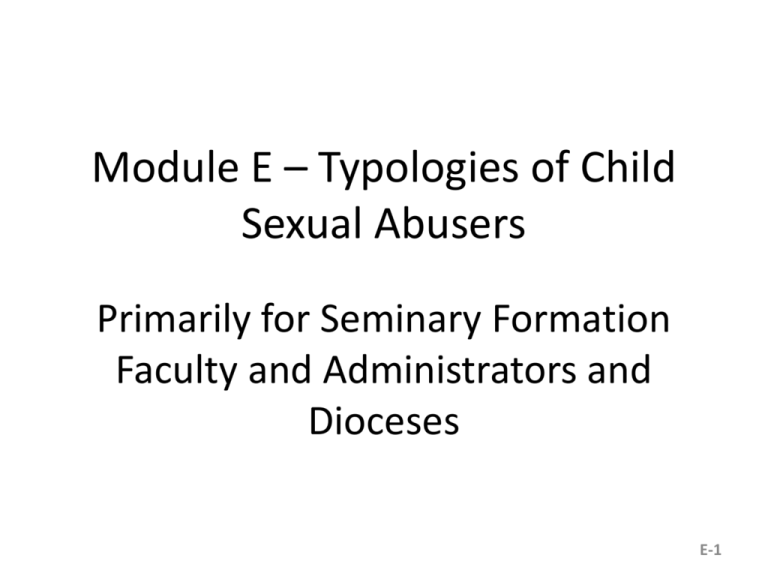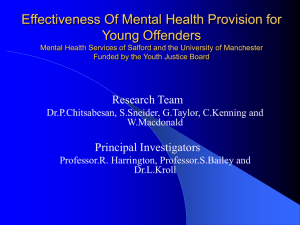
Module E – Typologies of Child
Sexual Abusers
Primarily for Seminary Formation
Faculty and Administrators and
Dioceses
E-1
Typologies of
Child Sexual Abusers in General
and Clergy Sexual Abusers in
Particular
E-2
Main Sources of Data
Reports presented to the United States Conference of
Catholic Bishops by the John Jay College Research Team,
The City University of New York*
• The Causes and Context of Sexual Abuse of Minors by
Catholic Priests in the United States, 1950-2010, March,
2011
• The Nature and Scope of Sexual Abuse of Minors by
Catholic Priests and Deacons in the United States, 19502002, February 2004
* The two reports are based on data supplied by 97 percent of U.S.
archdioceses and dioceses on all clergy accused of sexual abuse of minors
E-3
The distinction between fixated and regressed
sexual offending exists on a continuum and is
not simply a dichotomous distinction
Two issues that differentiate the types:
The degree to which deviant sexual behavior is
entrenched
The basis of the psychological needs that lead to
abuse
E-4
Fixated Offenders, 1: Definition
• From adolescence onward, fixated offenders
have persistent, continual, and compulsive
attraction exclusively to children
• They are usually diagnosed with pedophilia,
(recurrent, intense, sexually arousing
fantasies of at least six months in duration
involving prepubescent children), or show
characteristics of ephebophilia, which is
attraction to adolescents
E-5
Fixated Offenders, 2: Characteristics
• Fixated offenders are not fully psychosexually
developed and show emotional characteristics
of a child
• They do not develop past the point where they
find children attractive and desirable
• They are often unable to attain any degree of
psychosexual maturity, and during adulthood,
have virtually no age-appropriate sexual
relationship
E-6
Fixated Offenders, 3: Behaviors
• Fixated offenders develop relationships with
vulnerable children (in an emotional or
situational sense)
• They typically recruit, groom, and maintain
children for a continuing sexual relationship
• They delude themselves into believing they have
established a caring, supportive role with the
child and that the child is able to derive pleasure
and educational experience from the interaction
• Offenses are premeditated and do not stem from
stressors
E-7
Fixated Offenders, 4:
Primary Victim Preference
• Fixated offenders are more likely to choose
victims who are extra familial
• They generally choose prepubescent females
and pubescent or adolescent males
• They typically recruit vulnerable children
Typically, fixated offenders account for 5 to 10%
of child sexual abuse
E-8
Fixated Offenders, 5: Dangers
• Fixated offenders are able to persist in
offending for a long period
• They have more offenses because they
employ effective grooming techniques that
keep victims from reporting
• They have the highest rate of recidivism and
are likely to commit the most offenses
• They should be considered the highest risk to
the community
E-9
Regressed Offenders, 1: Definition
• Regressed offenders often begin offending in
adulthood
• Their offenses are triggered by stressors in the
environment, which undermine self-esteem and
confidence, and from disordered childhood
relationships
• They are not necessarily motivated by sexual
needs alone
Some 90 to 95% of child sexual abusers do not have a
diagnosis of pedophilia and fit within a regressed typology
E-10
Regressed Offenders, 2: Stressors
• Stressors can be situational, such as
unemployment, marital problems and
substance abuse
• They can be related to negative affective
states such as loneliness, isolation, or anxiety
• Stressors can lead to poor self-confidence
and low self-esteem, thereby undermining
the abusers’ confidence in themselves as men
E-11
Regressed Offenders, 3: Behaviors
• In sex-pressure offenses, regressed offenders
either entice or entrap the victim
• In the pursuit of sexual gratification, they
would prefer the victims cooperate, but
should they resist the offender usually will
not follow through with the sexually abusive
behavior
E-12
Regressed Offenders, 4: Behaviors (cont.)
• In sex-forced offenses, regressed offenders use
either intimidation or physical aggression
• They may be drawn to a particular victim
primarily because the victim is easily
overpowered and may present less resistance
than an adult
• They are using the victim purely as a means of
sexual release
• They are known as “sadistic” offenders because
they must inflict pain to achieve sexual
gratification – this is the rarest type of offender
E-13
Type of Offender
Situational offenders
Characteristics of Offenders (FBI)
Regressed
Offenders have poor coping skills, target victims
who are easily accessible, abuse children as a
substitute for adult relationships
Morally Indiscriminate
Offenders do not prefer children over adults and
tend to use children (or anyone accessible) for
their own interest (sexual and otherwise)
Sexually Indiscriminate
Offenders are mainly interested in sexual
experimentation, and abuse children out of
boredom
Inadequate
Offenders are social misfits who are insecure, have
low self-esteem, and see relationships with
children as their only sexual outlet
E-14
FBI Typologies: Preferential Offenders, 2
Type of Offender
Preferential offenders
Characteristics of Offenders (FBI)
Seductive
Offenders “court” children and give them
much affection, love, gifts, and enticements
in order to carry on a “relationship”
Fixated
Offenders have poor psychosexual
development, desire affection from children,
and are compulsively attracted to children
Sadistic
Offenders are aggressive, sexually excited by
violence, target stranger victims, and are
extremely dangerous
E-15
Some researchers have concluded that clergy offenders are
unique compared to offenders within the general population
•
One review of literature maintained that clergy offenders
displayed shyness, loneliness, and passivity
•
MMPI scores illustrated the presence of depression,
authority concerns, and addiction problems
•
Rorschach results indicated greater affect constriction
than normal
•
Offending clergy exhibited the presence of overcontrolled hostility more than non-offending clergy
E-16
Personality Characteristics of
Clergy Offenders, 2
One of the specific clergy studies found that offenders came
from backgrounds
•
Characterized by rigidity and dysfunction with themes of
abuse
•
Had little insight into these areas
•
Had insufficient training in the issue of transference/counter
transference
•
Had virtually no training or education concerning sexual
abuse, domestic violence, addictive disease, or healthy
professional boundaries, and
•
Failed to appreciate how their history of trauma affected
their professional life
E-17
Summary of Typologies
of Child Sexual Abusers
•
•
•
•
•
The Fixated Typology
Regressed Typology
FBI Typologies of Situational Offenders
FBI Typologies of Preferential Offenders
Personality Characteristics of Clergy
Offenders
E-18
Discussion Questions
•
•
•
•
•
What are the major differences between fixated and
regressed sexual offenders?
What differentiates situational from preferential offenders?
How do clergy sex offenders differ from the general
population of sex offenders?
What risk factors particular to clergy might be observed in
potential clergy sex offenders?
What are the essential ingredients of educational programs
that can help prevent sexual abuse?
Link to USCCB – http://www.usccb.org/issues-andaction/child-and-youth-protection/charter.cfm
E-19
Prepared by:
Sister Katarina Schuth, O.S.F., St. Paul Seminary
School of Divinity, University of St. Thomas
Technical Associate: Catherine Slight
Consultants:
Dr. Karen Terry and Margaret Smith, John Jay
College of Criminal Justice, authors of major studies
on sexual abuse for the USCCB;
Dr. Mary Gautier, Center for Applied Research in the
Apostolate
E-20








